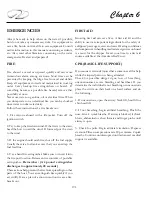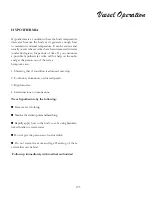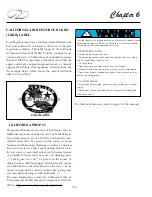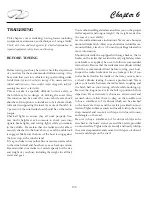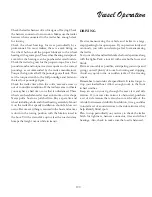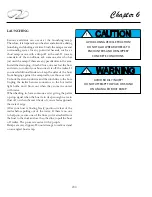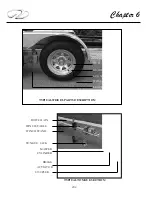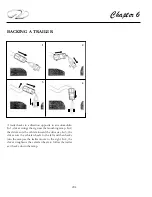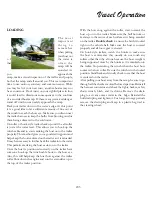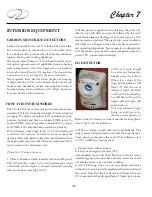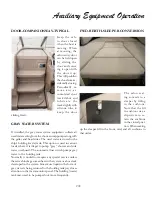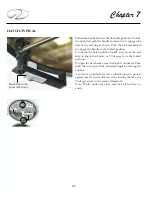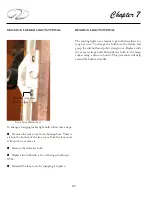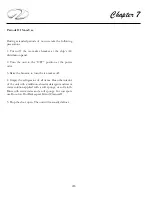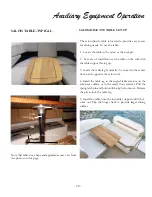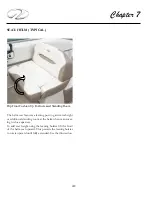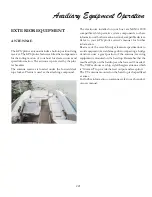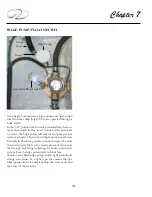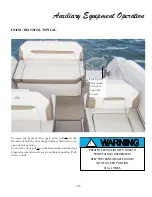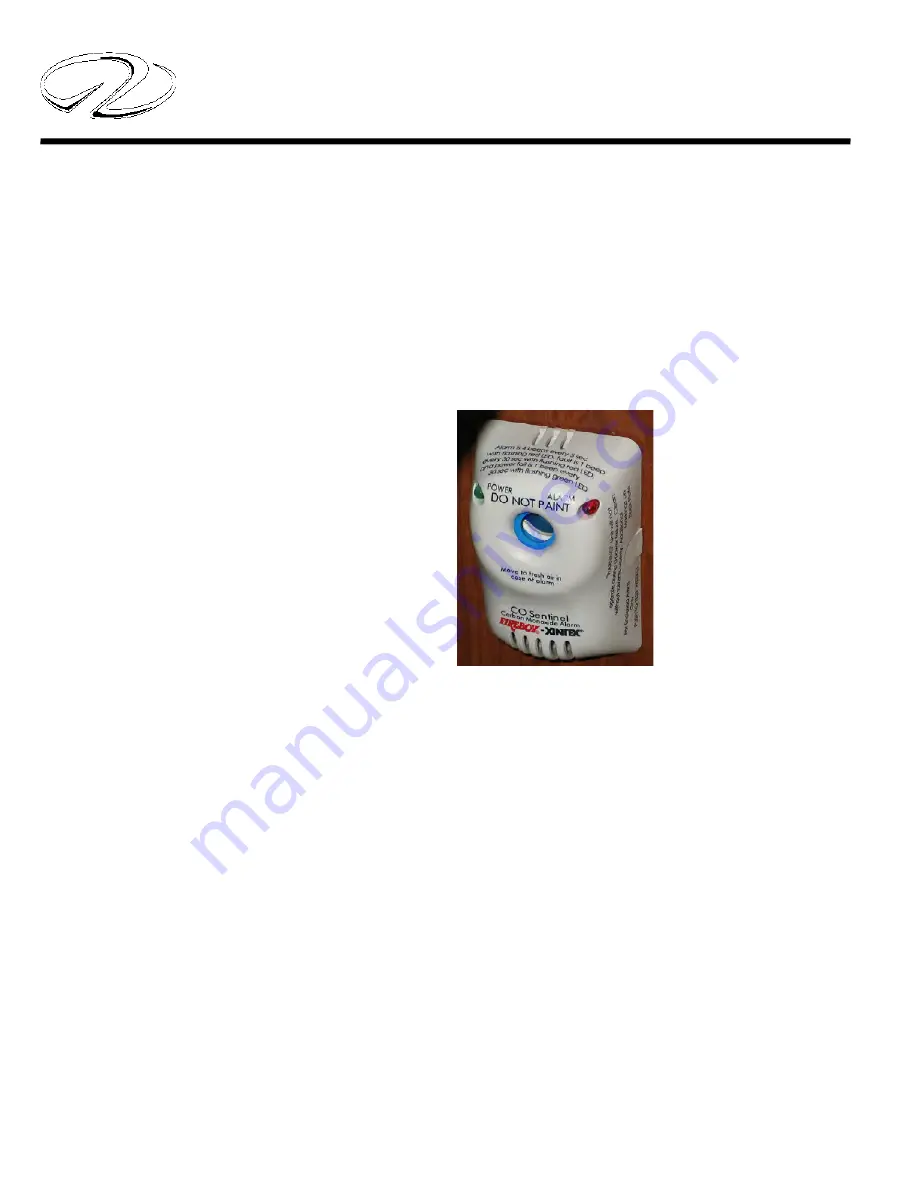
208
Chapter 7
CARBON MONOXIDE DETECTORS
Carbon monoxide known as CO is indeed the silent killer.
It is a by-product of combustion. CO is invisible, taste-
less, odorless and is produced by all internal combustion
engines, heating and cooking appliances.
The most common forms of CO on board vessels are pet-
rol engines/generators and if applicable, propane heating
and cooking devices.
Note: Even though your vessels propulsion
system is diesel based follow the CO precautions. Also, remember that
a vessel moored next to you may be a CO poison contributor.
Never operate these devices when people are sleeping.
A slight amount of CO in the human body over several
hours causes headaches, nausea and symptoms close to
food poisoning, motion sickness or flu. High concentra
-
tions can be fatal within minutes.
HOW THE SYSTEM WORKS
The CO detector uses a mini computer to measure and ac-
cumulate CO levels. Using the principle of “time weighted
averaging” the detector monitors CO concentrations, tem-
perature, humidity and time to calculate COHb levels. To
explain COHb, our bodies prefer to absorb CO to oxygen
and COHb is the absorbed ratio stated in a percent.
If the detector senses high levels of CO the alarm will
sound in a few minutes. If lower levels are sensed, the
detector will accumulate the data and sound an alarm when
the appropriate level is reached.
Read and understand the CO
owner’s manual in the information pouch.
To turn the CO detector system on:
1. There is a breaker switch located at the main DC panel.
The CO circuitry works to its best performance when
continually activated plus it accords advanced warning
when entering an area high in CO.
3. The test cycle should
be activated frequently.
Simply press the button.
When it is released, the
(top) power indicator will
flash off and the lower
indicator light will flash
on. Then, the lower indica-
tor will flash off and the
upper indicator light will
come back on.
The top indicator light
being on solid green in-
dicates
normal
operation.
Refer to the CO detectors owner’s manual for an explana-
tion of the test cycle indicators.
4. When an alarm sounds take action immediately. The
danger alarm indicator flashes red and the horn beeps 4
times, pauses and repeats the cycle. This indicates a rate
of 10% COHb has been reached.
a. Operate reset/silence button.
b. Call your emergency services (911)
c. Immediately move to fresh air. Do not re-enter the vessel.
until emergency personnel have arrived, aired the vessel
out and the alarm is in a normal condition.
d. After following steps a-c and your alarm reactivates
within a 24-hour period call a qualified technician to inspect
the vessel. Note that the CO detector will clear when the
CO concentration has dropped below 70 parts per minute.
CO DETECTOR
2. When power is applied to the detector, the power in-
dicator (top) will flash on and off, followed by the (red)
lower alarm indicator flashing off and on as part of a 8-14
minute warm-up period. The green (top) power indicator
will indicate a solid green when the unit has reached cor-
rect operating temperature. Never operate a cooking device
with the canvas up or the cabin door completely closed to
prevent CO concentration build-up
INTERIOR EQUIPMENT
Summary of Contents for 26 EXPRESS
Page 1: ...OWNER S MANUAL 26 EXPRESS 26 XO 4 2019...
Page 28: ...28 Chapter 2 NAVIGATION LIGHT RULES...
Page 50: ...50 Chapter 3...
Page 51: ...51 Rules Of The Road...
Page 73: ...73 Systems TYPICAL 12 VOLT HELM SWITCH PANELS PORT SWITCH PANEL STARBOARD SWITCH PANEL...
Page 121: ...121 Systems...
Page 122: ...122 Chapter 4...
Page 123: ...123 Systems...
Page 124: ...124 Chapter 4...
Page 125: ...125 Systems...
Page 126: ...126 Chapter 4...
Page 127: ...127 Systems...
Page 128: ...128 Chapter 4...
Page 129: ...129 Systems...
Page 130: ...130 Chapter 4...
Page 153: ...153 Engine Controls REGAL 26 XO TANK LABEL...
Page 177: ...177 Engine Controls SEA STAR STEERING SYSTEM SCHEMATIC OVERVIEW...
Page 262: ...262 Chapter 8 OVERBOARD DISCHARGE PAN DRAIN TYPICAL VECTOR COMPACT AC SYSTEM AIR FILTER...
Page 275: ...275 Cosmetic Care Maintenance...
Page 294: ...294 Chapter 9 HOT WATER HEATER...
Page 298: ...298 Chapter 9 STEREO DIAGNOSTIC CHART...
Page 299: ...299 Troubleshooting STEREO DIAGNOSTIC CHART...
Page 300: ...300 Chapter 9 STEREO DIAGNOSTIC CHART...
Page 303: ...303 Troubleshooting THRUSTER BOW...
Page 304: ...304 Chapter 9 TYPICAL WINDLASS...
Page 321: ...321 Technical Information TECHNICAL DRAWINGS...
Page 325: ...Technical Information 322 26 EXPRESS GALVANIC ISOLATOR WIRING...
Page 326: ...Technical Information 323 TYPICAL NMEA 2000 NETWORK COMPONENTS...
Page 328: ...Technical Information 325 26 EXPRESS TYPICAL DC GROUND CIRCUITRY...
Page 329: ...Technical Information 326 26 EXPRESS TYPICAL TRIM TAB SWITCH CIRCUITRY...
Page 330: ...Technical Information 327 26 EXPRESS TYPICAL GFCI CIRCUITRY...
Page 331: ...Technical Information 328 26 EXPRESS TYPICAL FIRE EXTINGUISHER GROUND CIRCUITRY...
Page 332: ...Technical Information 329 26 EXPRESS TYPICAL STEREO BLUETOOTH WIRING EARLIER...
Page 333: ...Technical Information 330 26 EXPRESS TYPICAL SWITCH PANEL HARNESS PLUG CIRCUITRY...
Page 334: ...Technical Information 331 26 EXPRESS TYPICAL SWITCH PANEL CIRCUITRY...
Page 335: ...Technical Information 332 26 EXPRESS BATTERY MANAGEMENT PANEL FRONT CIRCUITRY...
Page 336: ...Technical Information 333 26 EXPRESS BATTERY MANAGEMENT PANEL REAR CIRCUITRY...
Page 337: ...Technical Information 334 26 EXPRESS DOMESTIC 120 VOLT MAIN AC PANEL...
Page 338: ...Technical Information 335 26 EXPRESS OVERSEAS 230 VOLT MAIN AC PANEL...
Page 339: ...Technical Information 336 26 EXPRESS DOMESTIC 120 VOLT MAIN AC PANEL...
Page 340: ...Technical Information 337 26 EXPRESS GALLEY ELECTRIC BREAKOUT 1...
Page 341: ...Technical Information 338 26 EXPRESS GALLEY ELECTRIC BREAKOUT 2...
Page 342: ...Technical Information 339 26 EXPRESS GALLEY ELECTRIC BREAKOUT 3...
Page 343: ...Technical Information 340 26 EXPRESS GALLEY ELECTRIC BREAKOUT 4...
Page 344: ...Technical Information 341 26 EXPRESS GALLEY ELECTRIC BREAKOUT 5...
Page 345: ...Technical Information 342 26 EXPRESS GALLEY ELECTRIC BREAKOUT 6...
Page 347: ...Technical Information 344 26 EXPRESS MACHINERY LAYOUT PROFILE VIEW EXPLODED...
Page 348: ...Technical Information 345 26 EXPRESS MACHINERY LAYOUT TOP VIEW EXPLODED...
Page 353: ...Technical Information 350 26 EXPRESS TYPICAL BOW PLAN WINDLASS...
Page 359: ...Technical Information 356...
Page 360: ...Technical Information 357...
Page 361: ...Technical Information 358...
Page 362: ...Technical Information 359...
Page 363: ...Technical Information 360...
Page 364: ...Technical Information 361...
Page 365: ...Technical Information 362...
Page 366: ...Technical Information 363...
Page 367: ...Technical Information 364...
Page 368: ...Technical Information 365...
Page 369: ...Technical Information 366...
Page 370: ...Technical Information 367...
Page 371: ...Technical Information 368...
Page 373: ...Technical Information 370...
Page 374: ...Technical Information 371...
Page 375: ...Technical Information 372...
Page 376: ...Technical Information 373...
Page 377: ...Technical Information 374...
Page 379: ...Technical Information 376...
Page 381: ...Technical Information 378...
Page 382: ...Technical Information 379...
Page 383: ...Technical Information 380...
Page 384: ...Technical Information 381...
Page 386: ...Technical Information 383...
Page 387: ...Technical Information 384...
Page 388: ...Technical Information 385...
Page 389: ...Technical Information 386...

